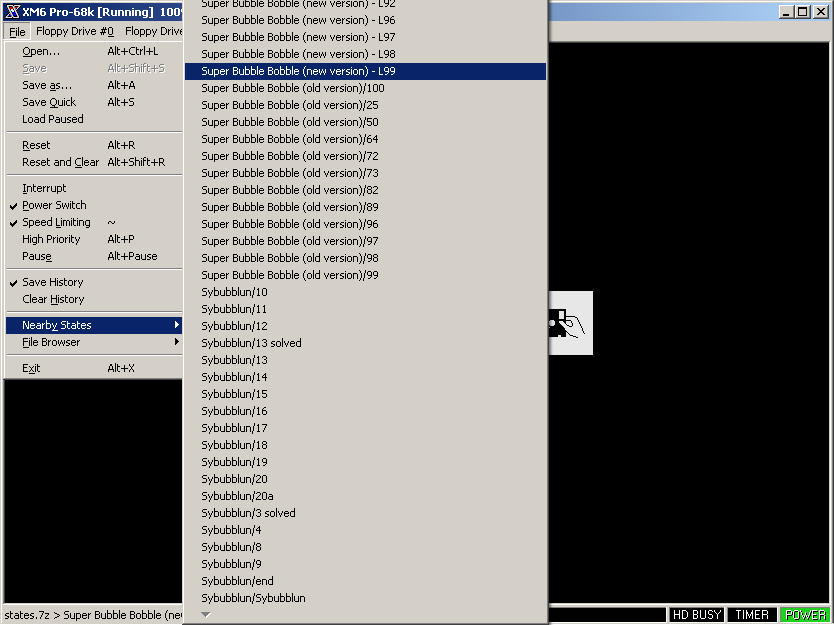


XM6 Pro-68k is an X68000 emulator for Windows. It is a derived from the venerable XM6, which was developed by PI.
(The X68000 was a high-spec Japanese computer billed as a personal workstation. It was powerful enough to run ports of contemporary arcade games without compromise.)
Originally the focus was on adding development/debugging features (hence the "pro" moniker), but more recently, the main goal has been improving the user interface and adding ease-of-use features, especially for English-language users. And people who use keyboard shortcuts.
It also strives to have the most accurate floppy drive emulation of any X68000 emulator.
Prominent general-interest additions/changes include:
You might also be interested in our X68000 floppy disk preservation project, which was directly responsible for this nice gallery.
Here is a list of JIS codes for manually inserting kanji or special characters.
Optional: Shortcuts can be added or removed at any time. Simply run XM6 Pro-68k and open the Tools menu. The Install and Uninstall submenus can be used to add or remove links to the program. The desktop shortcut comes with a hotkey (Ctrl-Shift-X) to launch the program, although it might not register until your next log-in.
You can check for (and download) updates by using the relevant menu item under the program's Help menu.
Running the "Download" batch file again will also work.
You will need 7-Zip (or a compatible program) to perform a manual installation. Download and extract the contents of each of the following packages into the same directory. If the packages extracted into separate directories, you must merge them into a single directory.
XM6 Pro-68k.7z (modification date here)
XM6 Pro-68k DLL Package Strongly recommended. Includes ZLIB1.DLL and CGROM.DAT.
XM6 Pro-68k Web Package Optional. Enables downloading game notes and updates to the program.
Note that the Automatic Installation above is essentially using the Web Package alone to download and extract the other packages; a manual installation is just a more challenging and less efficient method of accomplishing the same thing. If for some reason the Automatic Installation does not work for you, please report the problem so it can be fixed!
The Web Package has been updated to remove a dependency on Normaliz.dll, which was found to be unavailable in certain older operating systems.
It is not necessary to redownload it otherwise.
Support is available via email. There are no prerequisites at this time; you don't even have to bother reading the documentation first. Feature requests and bug reports are welcome. (If you do not report bugs, how do you expect them to be fixed?)
Send your emails to gmail user name mijeto. It could take a few days (worst case weeks) to receive a reply, so please be patient.
Do not include any links in your emails! If you did not get a reply to your XM6-related email back in 2024, it probably got erroneously marked as spam which I hadn't been checking at the time.
PI's new site has the original XM6 (from 2006) and currently seems to be distributing Gimons' excellent XM6 Type G fork for some reason.
A select few older versions of XM6 Pro-68k are also available: "2.05" 57.

This actually works now!
(Without special hardware, I mean. You do need two MIDI devices but they can be soft synths.)
![]()
If a disk image is recognized, icons will appear briefly upon insertion to let you know whether it is in the correct drive or not.
(It's more complicated than that; please read the manual for details.)
As the above example illustrates, one would be incorrect in assuming that the Disk labeled "II" should go into the second drive.
The red arrow indicates that it actually belongs in the first drive (except when you are watching the intro, in which case it should not be inserted at all).
The recently-used menus for the correct drives will be populated automatically to make it easier to move the disk.

Multiple disk images contained within the same archive (.zip or .7z) are supported.
Simply load the archive file as normal and then select a disk image (maximum of 16) from the menu.
For even more convenience, drag and drop an archive while holding Alt to load it into both drives.
Keyboard mnemonics are now available for files within archives to make switching disks even easier:
simply press the corresponding letter when the menu is open.

The above showcases XM6 Pro-68k after having loaded a 7-Zip archive containing 87 state files.
The size of the archive is less than a megabyte! On my development machine, in debug mode,
it took around half a second to load arbitrary state files from this particular archive, in the worst case.

The software keyboard window now shows feedback for multiple input devices. Blue and green represent controller inputs.
For example, the port-1 joystick's first button is represented by a blue '1' key and the axes are represented by the arrow keys.
Keyboard keys are shown in red as normal.

Up to 4 floppy drives are now supported. The TIMER and POWER indicators are replaced with FDD LEDs only when extra drives are attached.
The extra drives are only shown in the pop-up menu, not the main menu, since most people do not need them.
It's little more than a novelty, as very few games will take advantage of additional drives. (The game depicted in the screenshot above is a rare exception.)
You don't need this; it's just a licensing thing. No modifications were made: 7z1900-src.7z
See here instead for the latest version and other items of interest.